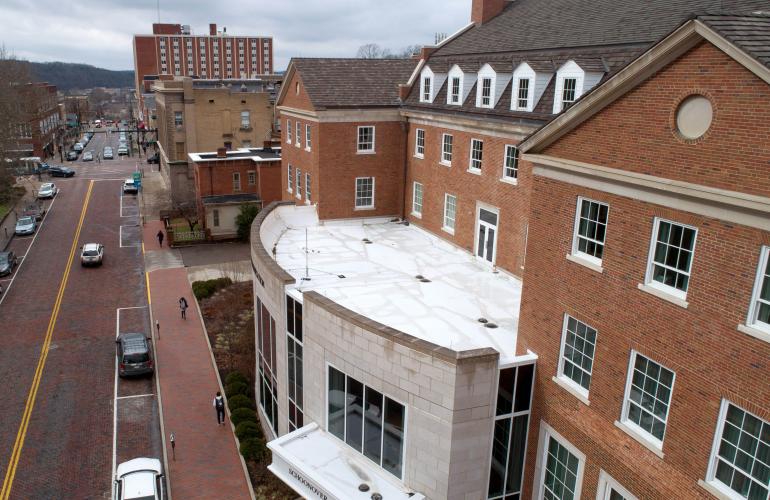

Ohio University faculty and students are developing a green roof to be installed this spring on the roof over the Schoonover Center lobby.
A series of grants, including an Academic Innovation Accelerator grant for $256,000, is making the project possible, said Dr. Kim Thompson, an assistant professor of instruction in the Department of Environmental and Plant Biology in the College of Arts and Sciences.
“It’s been a truly interdisciplinary process, and the goal is to make it accessible in some way to everyone on campus,” Thompson said. The green roof will be home to research projects, supported by a variety of equipment to track temperature, ultraviolet radiation, air quality, water runoff and water quality, and impacts on energy usage of the building, Thompson said.
“We want this to be something that helps us with our sustainability mission by educating students,” she said, adding that it fits with Ohio University’s goal of increasing sustainability literacy.
The space will also be more visually appealing to visitors to Schoonover’s third floor, who today have a view of a blank white space. Scripps College of Communication Dean Scott Titsworth said the space will serve as a strong sustainable, academic and aesthetic purpose.
“This green roof will serve a number of purposes across multiple disciplines and we are more than happy to be able to host it at Schoonover Center,” Titsworth said. “We look forward to the opportunity to collaborate with faculty and students as they develop and use the space and to sharing it with the rest of the University.”
While the roof, which will overlook Union Street and College Green, can hold a limited number of people at any given time, Thompson said Scripps College of Communication faculty will help make the space more readily accessible digitally, possibly through virtual reality. A 3-D image of the space is already available, for example.
“It sounds like it will be an incredible space that a lot of people are going to be able to see and enjoy,” said Matt Love, cinematographer and project manager in the Game Research and Immersive Design (GRID) Lab in the Scripps College of Communication. He said that the 3-D image can be recreated once the space is planted and information about some of the plants can be available through the website image. It could also be converted to a virtual reality experience, with pop-up information available through the headset.
“We use a new type of camera which captures not only images, but also has infrared sensors and the ability to create a 3D scan of the space, including distance information,” Love said. “it makes it possible for someone wearing a headset to actually move about the space.”
Thompson said faculty members from Arts and Sciences, Scripps, the Voinovich School of Leadership and Public Affairs, the Russ College of Engineering and Technology, and the Patton College of Education have all been involved in the project.
“We have a variety of classes introducing the green roof and we have been actively meeting with faculty around the university to find out how we can help engage students,” Thompson said. Students have already completed literature reviews and design projects, including green roof models built by engineering students, but we should have even more opportunities open up once the roof is planted.”
There will be four plots planted on the roof, with equipment integrated into the space, Thompson said. A new interdisciplinary student organization, The Green Initiative, will also be involved through outreach to the community, proposing policies for green infrastructure on campus and in the area, developing a social media presence for education and advocacy, she added.
“Getting the students engaged is one of my goals, to really help them find their own projects and take off with their own ideas.”
Associate Director of Sustainability Sam Crowl said green roofs provide a lot of benefits and noted that the Schoonover space was always designed to be a green roof.
“We should have energy savings, we should have a better insulator, and we’re dealing with storm water in a better way,” Crowl said. “It was just going to be a sustainable green roof, but now, it will be a laboratory.”

